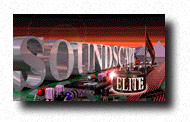
A sound card is an internal expansion card that provides input and output of audio signals to and from a computer under the control of computer programs. The term sound card is also applied to external audio interfaces used for professional audio applications.

Sound Blaster is a family of sound cards and audio peripherals designed by Singaporean technology company Creative Technology. The first Sound Blaster card was introduced in 1989.
Ensoniq Corp. was an American electronics manufacturer, best known throughout the mid-1980s and 1990s for its musical instruments, principally samplers and synthesizers.

The Gravis UltraSound or GUS is a sound card for the IBM PC compatible system platform, made by Canada-based Advanced Gravis Computer Technology Ltd. It was very popular in the demoscene during the 1990s.
Reaktor is a graphical modular software music studio developed by Native Instruments (NI). It allows musicians and sound specialists to design and build their own instruments, samplers, effects and sound design tools. It is supplied with many ready-to-use instruments and effects. In addition, free instruments can be downloaded from the User Library. All of Reaktor's instruments can be freely examined, customized, or taken apart, encouraging reverse engineering. The free, limited version called Reaktor Player allows musicians to play NI-released Reaktor instruments, but not edit or reverse-engineer them.

The Ensoniq Performance Sampler (EPS) was one of the first few affordable samplers on the market. It was manufactured from 1988 to 1991 by Ensoniq in Malvern, Pennsylvania, US. The EPS is a 13-bit sampler and replaced the Mirage - widely regarded as the first truly affordable sampling keyboard.
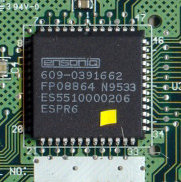
The Ensoniq ESP was used in many of the company's musical instruments and on their Soundscape Elite PC ISA sound card. It was used to enhance the synthesizer's audio samples with digital effects, enhancing the realism of the overall sound.
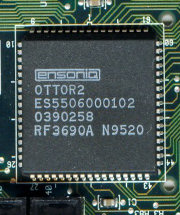
The Ensoniq ES-5506 "OTTO" is a chip used in implementations of sample-based synthesis. Musical instruments and IBM PC compatible sound cards were the most popular applications.

Soundscape S-2000 was Ensoniq's first direct foray into the PC sound card market. The card arrived on the market in 1994. It is a full-length ISA digital audio and sample-based synthesis device, equipped with a 2 MiB Ensoniq-built ROM-based patch set. Some OEM versions of the card feature a smaller 1 MiB patch set. It was praised for its then-high quality music synthesis and sound output, high compatibility and good software support.
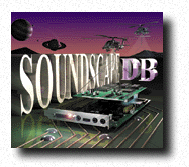
The SoundscapeDB is an Ensoniq-designed and produced MIDI daughtercard designed to interface with the "Waveblaster" pin header available on many older sound cards. It was released in 1994.
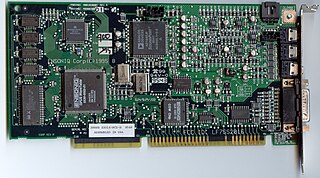
The Ensoniq Soundscape OPUS (SS-3016-NCD) is a Gateway 2000 OEM sound card, and possibly was used by other OEMs, but was never sold to Ensoniq's customers directly. It was a Soundscape-like board, using the Ensoniq "OPUS" multimedia sound chip that only was used on these OEM boards. It had a 1MB patch set ROM chip, resulting in a lesser MIDI quality compared to the Soundscape and Soundscape ELITE. The "OPUS" cards again carry the Motorola 68EC000 CPU. The variety of CD-ROM interfaces have been removed. Otherwise, however, the card is simply a cost-reduced Soundscape-compatible board with similar capabilities.

The Ensoniq AudioPCI is a Peripheral Component Interconnect (PCI)-based sound card released in 1997. It was Ensoniq's last sound card product before they were acquired by Creative Technology. The card represented a shift in Ensoniq's market positioning. Whereas the Soundscape line had been made up primarily of low-volume high-end products full of features, the AudioPCI was designed to be a very simple, low-cost product to appeal to system OEMs and thus hopefully sell in mass quantities.

Sound Blaster Live! is a PCI add-on sound card from Creative Technology Limited for PCs. Moving from ISA to PCI allowed the card to dispense with onboard memory, storing digital samples in the computer's main memory and then accessing them in real time over the bus. This allowed for a much wider selection of, and longer playing, samples. It also included higher quality sound output at all levels, quadrophonic output, and a new MIDI synthesizer with 64 sampled voices. The Live! was introduced on August 11, 1998 and variations on the design remained Creative's primary sound card line into the early 2000's.

The Sound Blaster 16 is a series of sound cards by Creative Technology, first released in June 1992 for PCs with an ISA or PCI slot. It was the successor to the Sound Blaster Pro series of sound cards and introduced CD-quality digital audio to the Sound Blaster line. For optional wavetable synthesis, the Sound Blaster 16 also added an expansion-header for add-on MIDI-daughterboards, called a Wave Blaster connector, and a game port for optional connection with external MIDI sound modules.

The Sound Blaster AWE32 is an ISA sound card from Creative Technology. It is an expansion board for PCs and is part of the Sound Blaster family of products. The Sound Blaster AWE32, introduced in March 1994, was a near full-length ISA sound card, measuring 14 inches (356 mm) in length, due to the number of features included.
The Ensoniq TS-10 was a synthesizer and music workstation introduced by Ensoniq in 1993. It provided synthesis, user sample playback, sequencer, effect units and performance facilities in a 61-key package.

Media Vision Technology, Inc., was an American electronics manufacturer of primarily computer sound cards and CD-ROM kits, operating from 1990 to approximately 1995 in Fremont, California. Media Vision was widely known for its Pro AudioSpectrum PC sound cards—which it often bundled with CD-ROM drives—it is also known for its spectacular growth and demise.
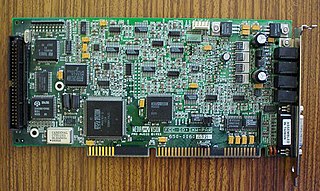
The Media Vision Pro AudioSpectrum family of personal computer sound cards included the original 8-bit Pro AudioSpectrum (1991), the 8-bit Pro AudioSpectrum Plus, 16-bit Pro AudioSpectrum 16, Pro AudioSpectrum 16 Basic and 16-bit Pro Audio Studio. All PAS cards with the exception of Pro AudioSpectrum 16 Basic could connect to CD-ROM drives—variants having SCSI or various proprietary interfaces—and many were sold in multimedia kits with compatible CD-ROM drives.

E-mu Systems was a software synthesizer, audio interface, MIDI interface, and MIDI keyboard manufacturer. Founded in 1971 as a synthesizer maker, E-mu was a pioneer in samplers, sample-based drum machines and low-cost digital sampling music workstations.
